Ades Cash & Carry: CSR, Employee Engagement, and Sustainability
VerifiedAdded on 2020/01/28
|22
|6817
|170
Report
AI Summary
This report delves into the realm of Corporate Social Responsibility (CSR) and its significant impact on employee engagement and sustainable development, using Ades Cash & Carry as a case study. It begins by establishing the aims, objectives, and timeframes for the project, focusing on how CSR initiatives can foster employee engagement and contribute to the organization's long-term sustainability. The research process includes a comprehensive project management plan divided into initiation, planning, execution, monitoring, and closure phases. The report incorporates both quantitative and qualitative data analysis, including surveys and stakeholder interviews, to assess the effectiveness of current employee engagement programs and identify areas for improvement. The findings highlight the importance of integrating CSR into the business structure to enhance employee productivity, satisfaction, and organizational success. Recommendations are provided to address issues and optimize employee engagement strategies for sustainable growth and competitive advantage within Ades Cash & Carry.
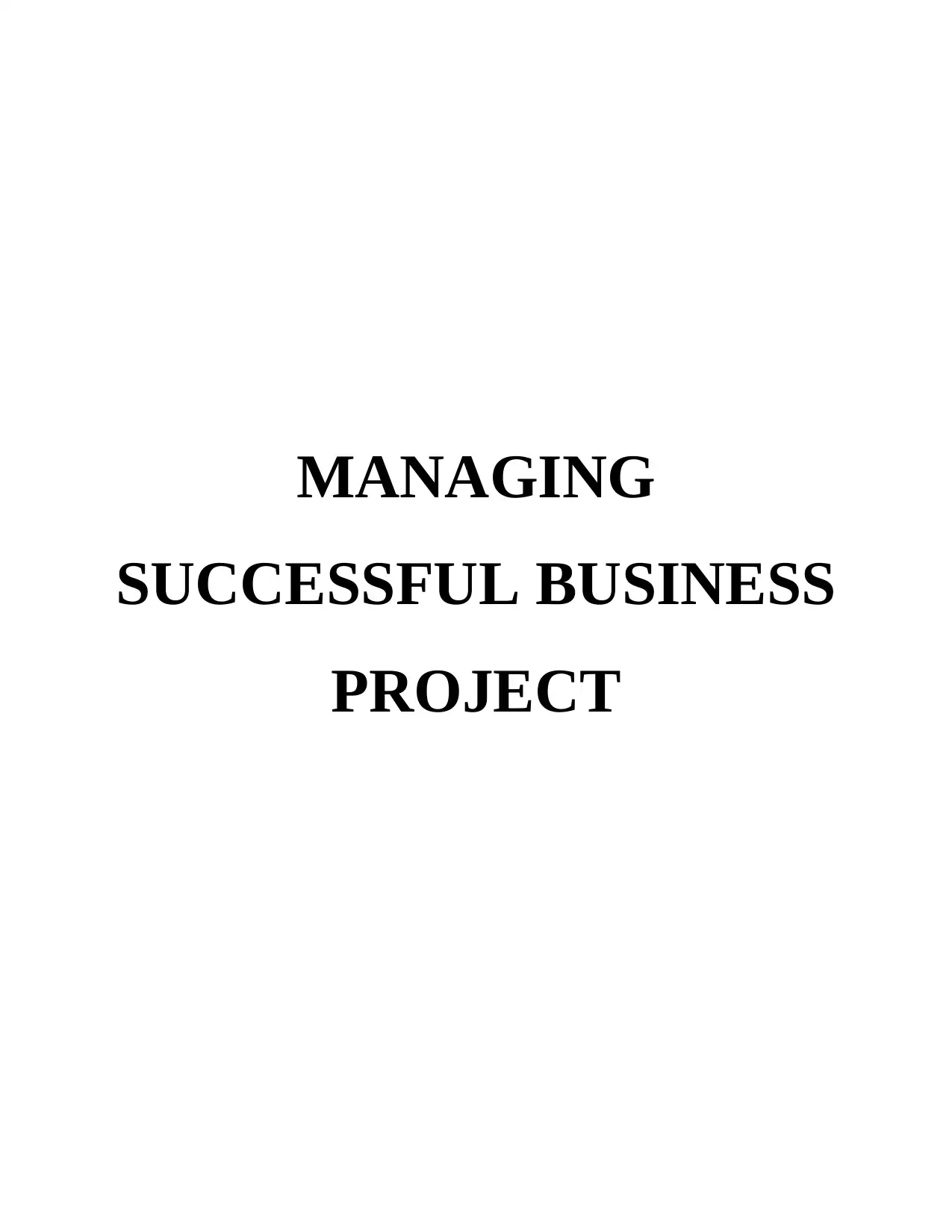
MANAGING
SUCCESSFUL BUSINESS
PROJECT
SUCCESSFUL BUSINESS
PROJECT
Paraphrase This Document
Need a fresh take? Get an instant paraphrase of this document with our AI Paraphraser

TABLE OF CONTENTS
INTRODUCTION...........................................................................................................................1
Task 1...............................................................................................................................................1
LO 1: Establishing aims, objectives, and timeframes (P1, P2, & P3).............................................1
Task 2...............................................................................................................................................7
LO2 Conduct small- scale research, information gathering and data collection, generating
knowledge to support the project as specified above: (P4).............................................................7
Task 3 ............................................................................................................................................13
LO3 Presenting the data collected and communicating recommendations based on conclusions
drawn from the findings made (P5, P6).........................................................................................13
LO 4: Reflection on undertaking the assignment..........................................................................16
CONCLUSION..............................................................................................................................18
REFERENCES..............................................................................................................................19
INTRODUCTION...........................................................................................................................1
Task 1...............................................................................................................................................1
LO 1: Establishing aims, objectives, and timeframes (P1, P2, & P3).............................................1
Task 2...............................................................................................................................................7
LO2 Conduct small- scale research, information gathering and data collection, generating
knowledge to support the project as specified above: (P4).............................................................7
Task 3 ............................................................................................................................................13
LO3 Presenting the data collected and communicating recommendations based on conclusions
drawn from the findings made (P5, P6).........................................................................................13
LO 4: Reflection on undertaking the assignment..........................................................................16
CONCLUSION..............................................................................................................................18
REFERENCES..............................................................................................................................19

INTRODUCTION
The term corporate social responsibility refers to the myriad business practices that
involves the initiatives which falls for the benefit of the society. It helps in maintaining the
balance between the ecosystem and the economy of the country. In addition to that, it helps in
the growth of the nation and in relevcance to that; it helps in the upliftment of the organization.
In other words it can also mentioned a typology of ethical framework that aids or assists in the
promotion of an entity. A business corporate social responsibility constitutes a wide range of
tactics, which ranges from rendering a company’s portion to the charity to implementing a more
greener and environmental friendly atmosphere. In this report, the corporate social responsibility
is elaborated vividly and the importance of its usage in the attainment of sustainability and
competitive advantage is explored. A complete research process is adopted and the data analysis
is analyzed in detail in this report. In addition to that, the recommendations are also suggested to
mitigate the various issues that have cropped up in this report.
Task 1
LO 1: Establishing aims, objectives, and timeframes (P1, P2, & P3)
Corporate Social Responsibility is an age old concept in United Kingdom. This concept
of CSR was first established in 19th century in Britain as opined by Heagney (2016). CSR scope
was widened when corporate objectives were introduced with social responsibilities and due to
this inclusion organization has a responsibility towards environment, employees, and social
economic structure. Globalization also helped in highlighting the importance of corporate social
responsibilities. The term CSR has very wide and complex meanings. According to Jeong, Bae
and Jeong (2015, p.832) generally when corporate or business organizations have a aim for
welfare of the society then such activities is called CSR. By attaining CSR an organization
achieves its balance in economy, environment, and social imperatives.
Sustainable development concept is based on organizational system thinking. Sustainable
developments have various meanings. For determining sustainable development there are few
things that needs to be focused on, such as, meeting needs, ethical values, environmental, social,
and economic, human rights, cooperation. Corporate social responsibility focuses on social and
environmental relationships, stakeholder approach, ethical behaviors, and volunteering.
1
The term corporate social responsibility refers to the myriad business practices that
involves the initiatives which falls for the benefit of the society. It helps in maintaining the
balance between the ecosystem and the economy of the country. In addition to that, it helps in
the growth of the nation and in relevcance to that; it helps in the upliftment of the organization.
In other words it can also mentioned a typology of ethical framework that aids or assists in the
promotion of an entity. A business corporate social responsibility constitutes a wide range of
tactics, which ranges from rendering a company’s portion to the charity to implementing a more
greener and environmental friendly atmosphere. In this report, the corporate social responsibility
is elaborated vividly and the importance of its usage in the attainment of sustainability and
competitive advantage is explored. A complete research process is adopted and the data analysis
is analyzed in detail in this report. In addition to that, the recommendations are also suggested to
mitigate the various issues that have cropped up in this report.
Task 1
LO 1: Establishing aims, objectives, and timeframes (P1, P2, & P3)
Corporate Social Responsibility is an age old concept in United Kingdom. This concept
of CSR was first established in 19th century in Britain as opined by Heagney (2016). CSR scope
was widened when corporate objectives were introduced with social responsibilities and due to
this inclusion organization has a responsibility towards environment, employees, and social
economic structure. Globalization also helped in highlighting the importance of corporate social
responsibilities. The term CSR has very wide and complex meanings. According to Jeong, Bae
and Jeong (2015, p.832) generally when corporate or business organizations have a aim for
welfare of the society then such activities is called CSR. By attaining CSR an organization
achieves its balance in economy, environment, and social imperatives.
Sustainable development concept is based on organizational system thinking. Sustainable
developments have various meanings. For determining sustainable development there are few
things that needs to be focused on, such as, meeting needs, ethical values, environmental, social,
and economic, human rights, cooperation. Corporate social responsibility focuses on social and
environmental relationships, stakeholder approach, ethical behaviors, and volunteering.
1
⊘ This is a preview!⊘
Do you want full access?
Subscribe today to unlock all pages.

Trusted by 1+ million students worldwide
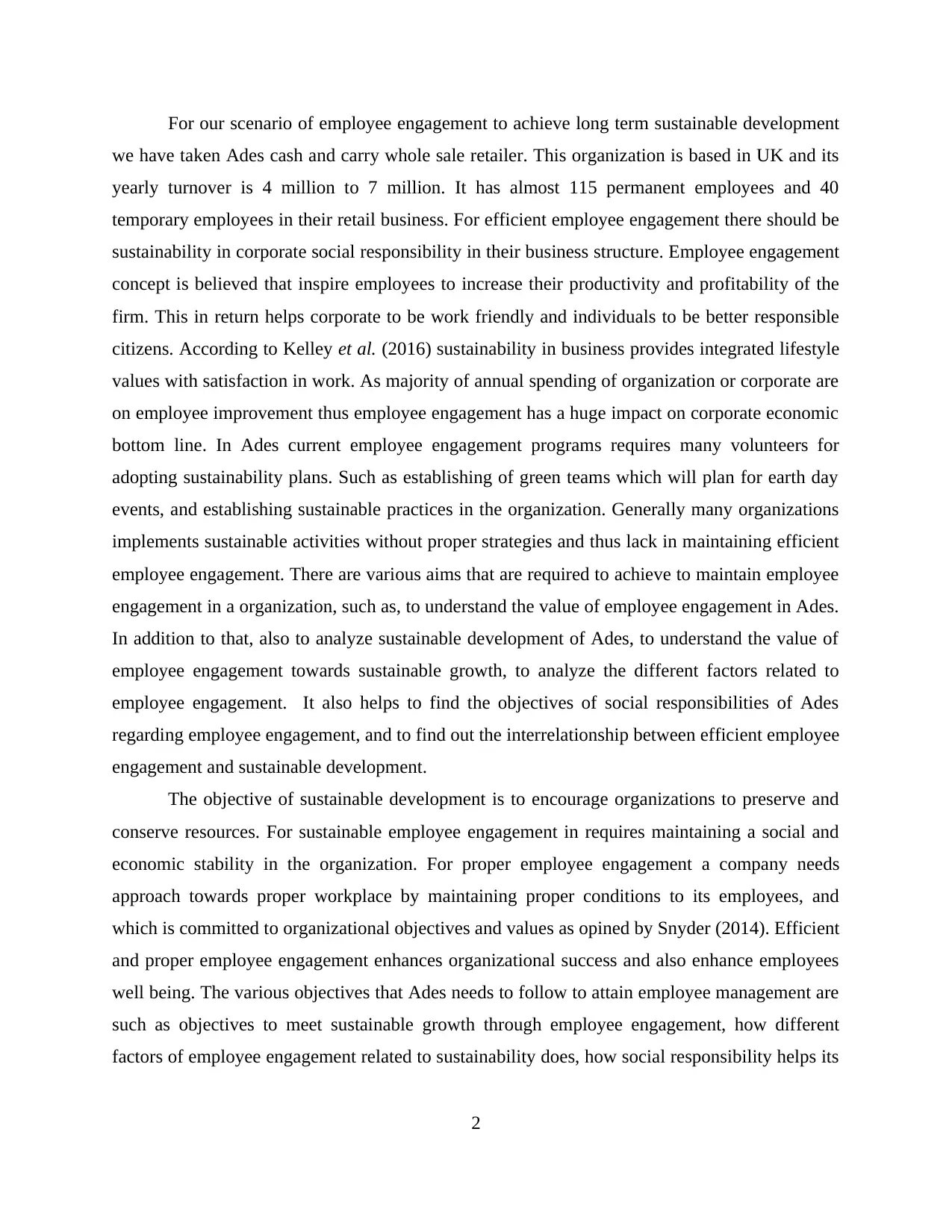
For our scenario of employee engagement to achieve long term sustainable development
we have taken Ades cash and carry whole sale retailer. This organization is based in UK and its
yearly turnover is 4 million to 7 million. It has almost 115 permanent employees and 40
temporary employees in their retail business. For efficient employee engagement there should be
sustainability in corporate social responsibility in their business structure. Employee engagement
concept is believed that inspire employees to increase their productivity and profitability of the
firm. This in return helps corporate to be work friendly and individuals to be better responsible
citizens. According to Kelley et al. (2016) sustainability in business provides integrated lifestyle
values with satisfaction in work. As majority of annual spending of organization or corporate are
on employee improvement thus employee engagement has a huge impact on corporate economic
bottom line. In Ades current employee engagement programs requires many volunteers for
adopting sustainability plans. Such as establishing of green teams which will plan for earth day
events, and establishing sustainable practices in the organization. Generally many organizations
implements sustainable activities without proper strategies and thus lack in maintaining efficient
employee engagement. There are various aims that are required to achieve to maintain employee
engagement in a organization, such as, to understand the value of employee engagement in Ades.
In addition to that, also to analyze sustainable development of Ades, to understand the value of
employee engagement towards sustainable growth, to analyze the different factors related to
employee engagement. It also helps to find the objectives of social responsibilities of Ades
regarding employee engagement, and to find out the interrelationship between efficient employee
engagement and sustainable development.
The objective of sustainable development is to encourage organizations to preserve and
conserve resources. For sustainable employee engagement in requires maintaining a social and
economic stability in the organization. For proper employee engagement a company needs
approach towards proper workplace by maintaining proper conditions to its employees, and
which is committed to organizational objectives and values as opined by Snyder (2014). Efficient
and proper employee engagement enhances organizational success and also enhance employees
well being. The various objectives that Ades needs to follow to attain employee management are
such as objectives to meet sustainable growth through employee engagement, how different
factors of employee engagement related to sustainability does, how social responsibility helps its
2
we have taken Ades cash and carry whole sale retailer. This organization is based in UK and its
yearly turnover is 4 million to 7 million. It has almost 115 permanent employees and 40
temporary employees in their retail business. For efficient employee engagement there should be
sustainability in corporate social responsibility in their business structure. Employee engagement
concept is believed that inspire employees to increase their productivity and profitability of the
firm. This in return helps corporate to be work friendly and individuals to be better responsible
citizens. According to Kelley et al. (2016) sustainability in business provides integrated lifestyle
values with satisfaction in work. As majority of annual spending of organization or corporate are
on employee improvement thus employee engagement has a huge impact on corporate economic
bottom line. In Ades current employee engagement programs requires many volunteers for
adopting sustainability plans. Such as establishing of green teams which will plan for earth day
events, and establishing sustainable practices in the organization. Generally many organizations
implements sustainable activities without proper strategies and thus lack in maintaining efficient
employee engagement. There are various aims that are required to achieve to maintain employee
engagement in a organization, such as, to understand the value of employee engagement in Ades.
In addition to that, also to analyze sustainable development of Ades, to understand the value of
employee engagement towards sustainable growth, to analyze the different factors related to
employee engagement. It also helps to find the objectives of social responsibilities of Ades
regarding employee engagement, and to find out the interrelationship between efficient employee
engagement and sustainable development.
The objective of sustainable development is to encourage organizations to preserve and
conserve resources. For sustainable employee engagement in requires maintaining a social and
economic stability in the organization. For proper employee engagement a company needs
approach towards proper workplace by maintaining proper conditions to its employees, and
which is committed to organizational objectives and values as opined by Snyder (2014). Efficient
and proper employee engagement enhances organizational success and also enhance employees
well being. The various objectives that Ades needs to follow to attain employee management are
such as objectives to meet sustainable growth through employee engagement, how different
factors of employee engagement related to sustainability does, how social responsibility helps its
2
Paraphrase This Document
Need a fresh take? Get an instant paraphrase of this document with our AI Paraphraser
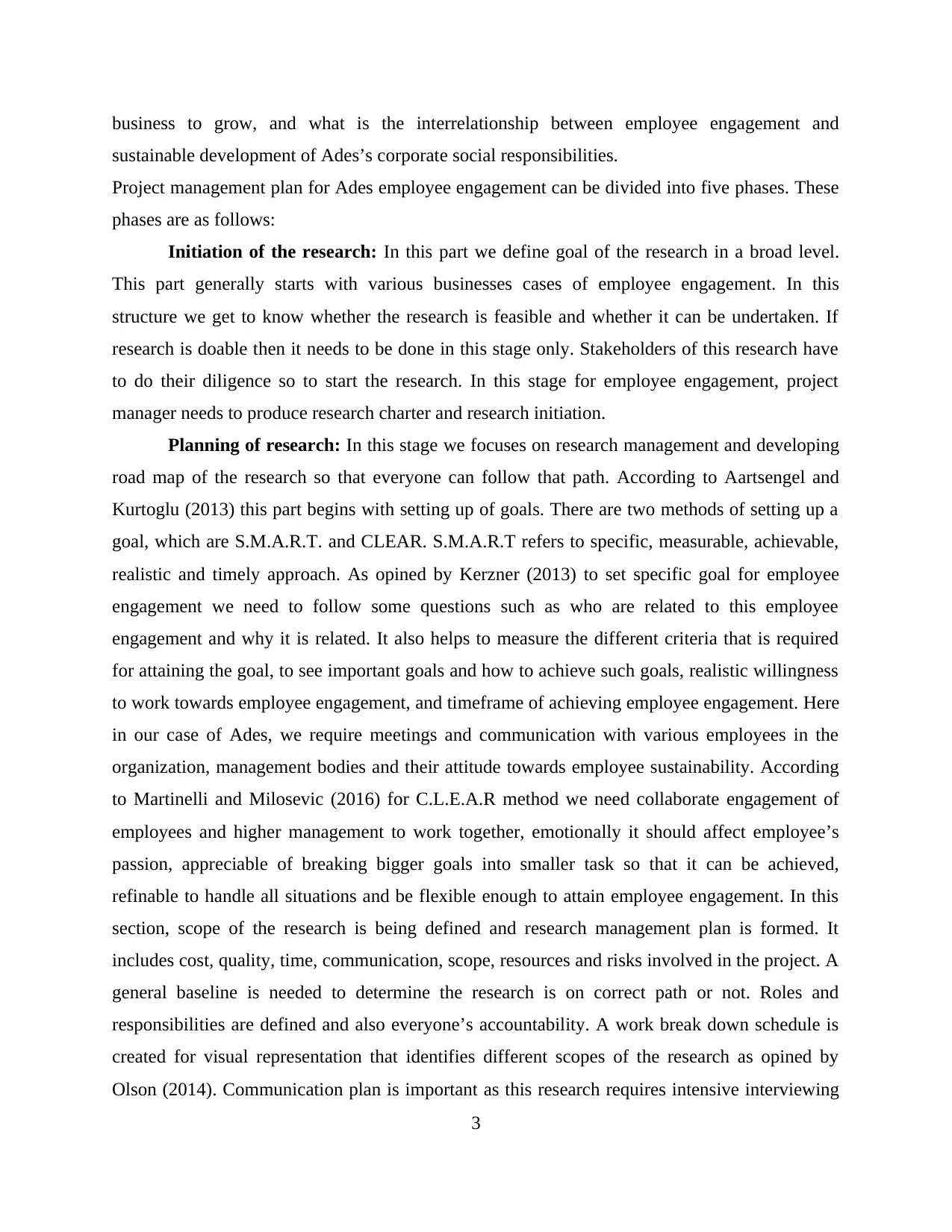
business to grow, and what is the interrelationship between employee engagement and
sustainable development of Ades’s corporate social responsibilities.
Project management plan for Ades employee engagement can be divided into five phases. These
phases are as follows:
Initiation of the research: In this part we define goal of the research in a broad level.
This part generally starts with various businesses cases of employee engagement. In this
structure we get to know whether the research is feasible and whether it can be undertaken. If
research is doable then it needs to be done in this stage only. Stakeholders of this research have
to do their diligence so to start the research. In this stage for employee engagement, project
manager needs to produce research charter and research initiation.
Planning of research: In this stage we focuses on research management and developing
road map of the research so that everyone can follow that path. According to Aartsengel and
Kurtoglu (2013) this part begins with setting up of goals. There are two methods of setting up a
goal, which are S.M.A.R.T. and CLEAR. S.M.A.R.T refers to specific, measurable, achievable,
realistic and timely approach. As opined by Kerzner (2013) to set specific goal for employee
engagement we need to follow some questions such as who are related to this employee
engagement and why it is related. It also helps to measure the different criteria that is required
for attaining the goal, to see important goals and how to achieve such goals, realistic willingness
to work towards employee engagement, and timeframe of achieving employee engagement. Here
in our case of Ades, we require meetings and communication with various employees in the
organization, management bodies and their attitude towards employee sustainability. According
to Martinelli and Milosevic (2016) for C.L.E.A.R method we need collaborate engagement of
employees and higher management to work together, emotionally it should affect employee’s
passion, appreciable of breaking bigger goals into smaller task so that it can be achieved,
refinable to handle all situations and be flexible enough to attain employee engagement. In this
section, scope of the research is being defined and research management plan is formed. It
includes cost, quality, time, communication, scope, resources and risks involved in the project. A
general baseline is needed to determine the research is on correct path or not. Roles and
responsibilities are defined and also everyone’s accountability. A work break down schedule is
created for visual representation that identifies different scopes of the research as opined by
Olson (2014). Communication plan is important as this research requires intensive interviewing
3
sustainable development of Ades’s corporate social responsibilities.
Project management plan for Ades employee engagement can be divided into five phases. These
phases are as follows:
Initiation of the research: In this part we define goal of the research in a broad level.
This part generally starts with various businesses cases of employee engagement. In this
structure we get to know whether the research is feasible and whether it can be undertaken. If
research is doable then it needs to be done in this stage only. Stakeholders of this research have
to do their diligence so to start the research. In this stage for employee engagement, project
manager needs to produce research charter and research initiation.
Planning of research: In this stage we focuses on research management and developing
road map of the research so that everyone can follow that path. According to Aartsengel and
Kurtoglu (2013) this part begins with setting up of goals. There are two methods of setting up a
goal, which are S.M.A.R.T. and CLEAR. S.M.A.R.T refers to specific, measurable, achievable,
realistic and timely approach. As opined by Kerzner (2013) to set specific goal for employee
engagement we need to follow some questions such as who are related to this employee
engagement and why it is related. It also helps to measure the different criteria that is required
for attaining the goal, to see important goals and how to achieve such goals, realistic willingness
to work towards employee engagement, and timeframe of achieving employee engagement. Here
in our case of Ades, we require meetings and communication with various employees in the
organization, management bodies and their attitude towards employee sustainability. According
to Martinelli and Milosevic (2016) for C.L.E.A.R method we need collaborate engagement of
employees and higher management to work together, emotionally it should affect employee’s
passion, appreciable of breaking bigger goals into smaller task so that it can be achieved,
refinable to handle all situations and be flexible enough to attain employee engagement. In this
section, scope of the research is being defined and research management plan is formed. It
includes cost, quality, time, communication, scope, resources and risks involved in the project. A
general baseline is needed to determine the research is on correct path or not. Roles and
responsibilities are defined and also everyone’s accountability. A work break down schedule is
created for visual representation that identifies different scopes of the research as opined by
Olson (2014). Communication plan is important as this research requires intensive interviewing
3
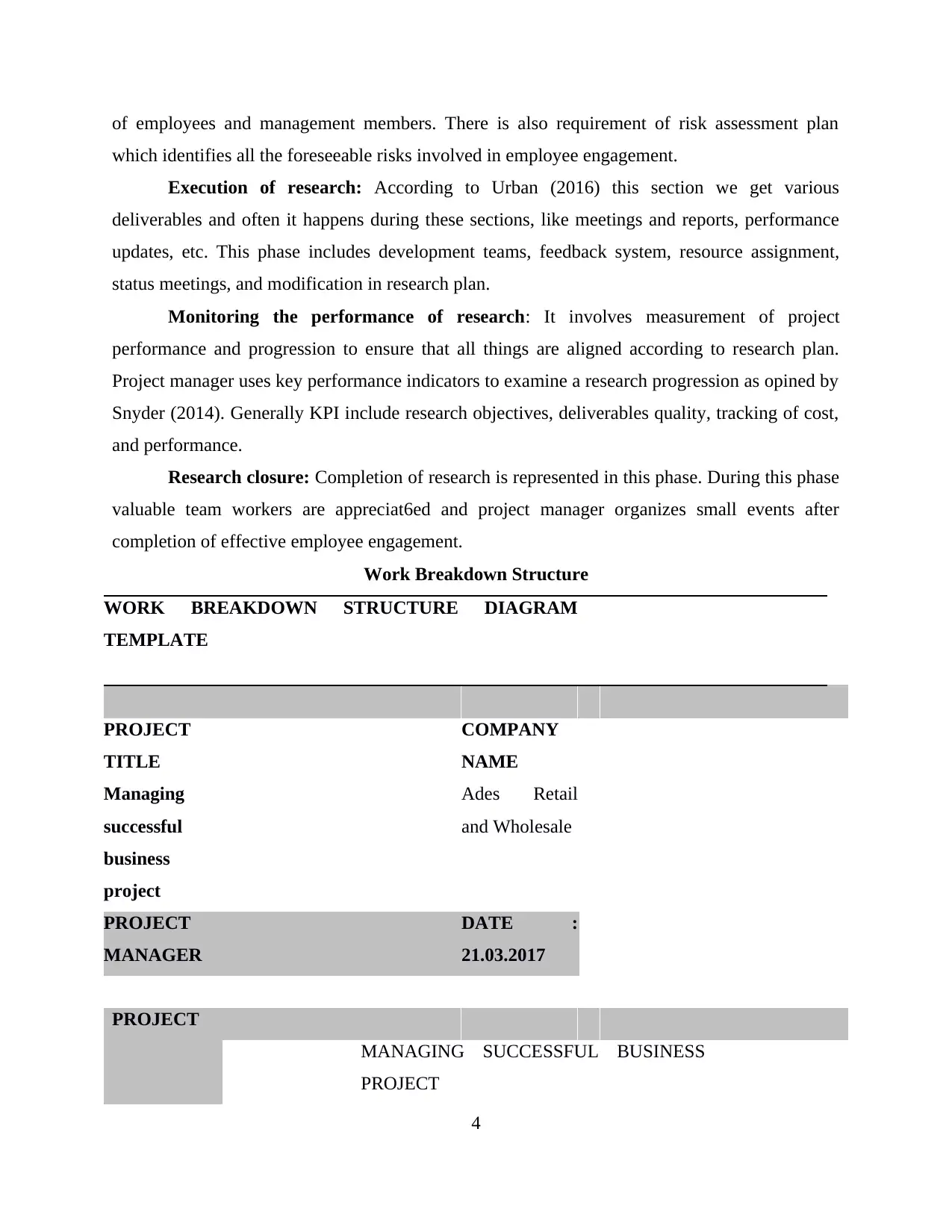
of employees and management members. There is also requirement of risk assessment plan
which identifies all the foreseeable risks involved in employee engagement.
Execution of research: According to Urban (2016) this section we get various
deliverables and often it happens during these sections, like meetings and reports, performance
updates, etc. This phase includes development teams, feedback system, resource assignment,
status meetings, and modification in research plan.
Monitoring the performance of research: It involves measurement of project
performance and progression to ensure that all things are aligned according to research plan.
Project manager uses key performance indicators to examine a research progression as opined by
Snyder (2014). Generally KPI include research objectives, deliverables quality, tracking of cost,
and performance.
Research closure: Completion of research is represented in this phase. During this phase
valuable team workers are appreciat6ed and project manager organizes small events after
completion of effective employee engagement.
Work Breakdown Structure
WORK BREAKDOWN STRUCTURE DIAGRAM
TEMPLATE
PROJECT
TITLE
Managing
successful
business
project
COMPANY
NAME
Ades Retail
and Wholesale
PROJECT
MANAGER
DATE :
21.03.2017
PROJECT
MANAGING SUCCESSFUL BUSINESS
PROJECT
4
which identifies all the foreseeable risks involved in employee engagement.
Execution of research: According to Urban (2016) this section we get various
deliverables and often it happens during these sections, like meetings and reports, performance
updates, etc. This phase includes development teams, feedback system, resource assignment,
status meetings, and modification in research plan.
Monitoring the performance of research: It involves measurement of project
performance and progression to ensure that all things are aligned according to research plan.
Project manager uses key performance indicators to examine a research progression as opined by
Snyder (2014). Generally KPI include research objectives, deliverables quality, tracking of cost,
and performance.
Research closure: Completion of research is represented in this phase. During this phase
valuable team workers are appreciat6ed and project manager organizes small events after
completion of effective employee engagement.
Work Breakdown Structure
WORK BREAKDOWN STRUCTURE DIAGRAM
TEMPLATE
PROJECT
TITLE
Managing
successful
business
project
COMPANY
NAME
Ades Retail
and Wholesale
PROJECT
MANAGER
DATE :
21.03.2017
PROJECT
MANAGING SUCCESSFUL BUSINESS
PROJECT
4
⊘ This is a preview!⊘
Do you want full access?
Subscribe today to unlock all pages.

Trusted by 1+ million students worldwide
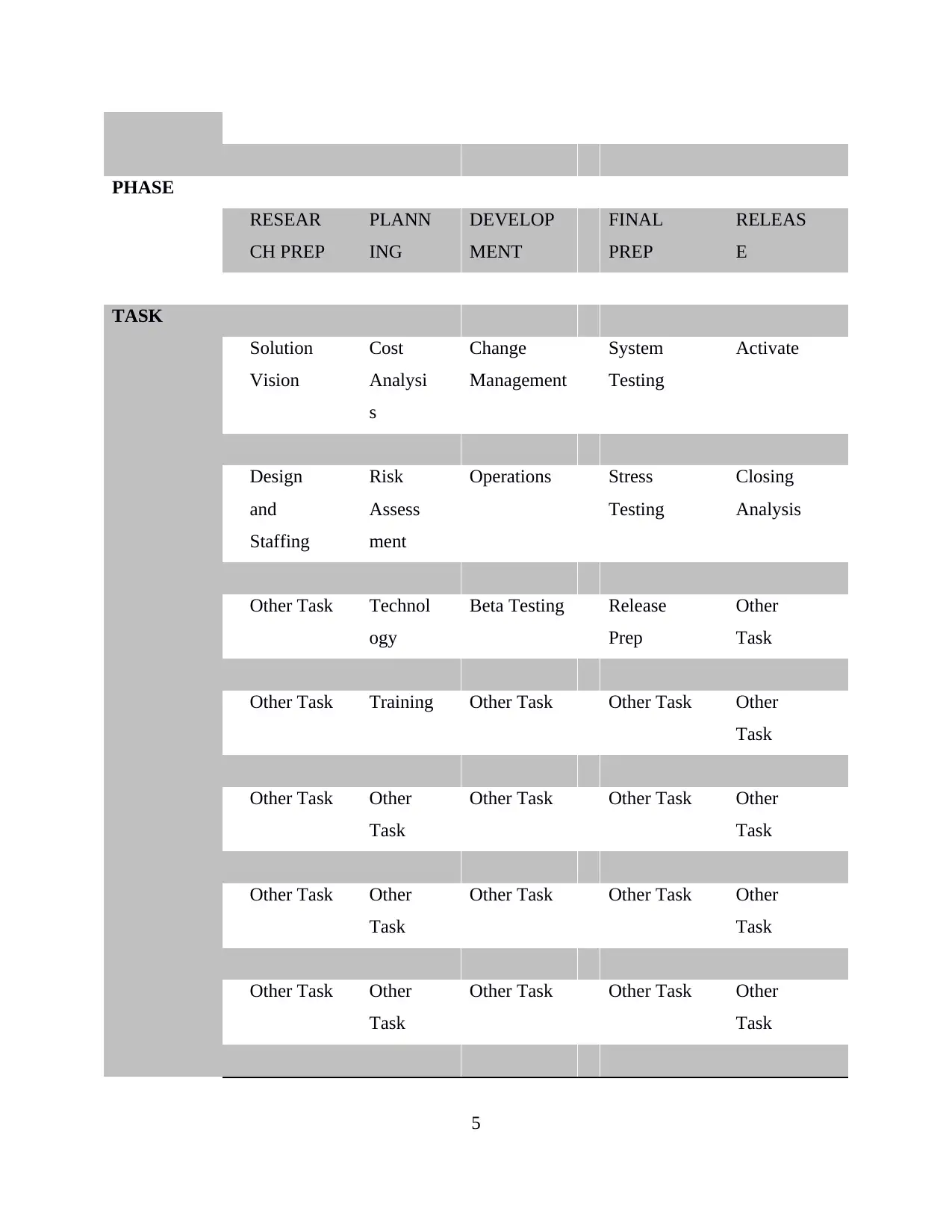
PHASE
RESEAR
CH PREP
PLANN
ING
DEVELOP
MENT
FINAL
PREP
RELEAS
E
TASK
Solution
Vision
Cost
Analysi
s
Change
Management
System
Testing
Activate
Design
and
Staffing
Risk
Assess
ment
Operations Stress
Testing
Closing
Analysis
Other Task Technol
ogy
Beta Testing Release
Prep
Other
Task
Other Task Training Other Task Other Task Other
Task
Other Task Other
Task
Other Task Other Task Other
Task
Other Task Other
Task
Other Task Other Task Other
Task
Other Task Other
Task
Other Task Other Task Other
Task
5
RESEAR
CH PREP
PLANN
ING
DEVELOP
MENT
FINAL
PREP
RELEAS
E
TASK
Solution
Vision
Cost
Analysi
s
Change
Management
System
Testing
Activate
Design
and
Staffing
Risk
Assess
ment
Operations Stress
Testing
Closing
Analysis
Other Task Technol
ogy
Beta Testing Release
Prep
Other
Task
Other Task Training Other Task Other Task Other
Task
Other Task Other
Task
Other Task Other Task Other
Task
Other Task Other
Task
Other Task Other Task Other
Task
Other Task Other
Task
Other Task Other Task Other
Task
5
Paraphrase This Document
Need a fresh take? Get an instant paraphrase of this document with our AI Paraphraser

Gnatt Chart
Activities week 1
to 2
Week 3
to 8
Week 9
to 13
Week 14
to 18
Week
19 to
21
Week
22 to
23
Wee
k 24
Cost of
each
activit
y
Research selection 345
Data Collection 480
Planning 260
Existing literatures
are reviewed
550
Development of
research plan
375
Choosing research
techniques
760
Primary collection of
data
550
Collection of Analysis 920
Findings 640
Conclusion and
recommendation
1150
Development of 220
6
Activities week 1
to 2
Week 3
to 8
Week 9
to 13
Week 14
to 18
Week
19 to
21
Week
22 to
23
Wee
k 24
Cost of
each
activit
y
Research selection 345
Data Collection 480
Planning 260
Existing literatures
are reviewed
550
Development of
research plan
375
Choosing research
techniques
760
Primary collection of
data
550
Collection of Analysis 920
Findings 640
Conclusion and
recommendation
1150
Development of 220
6

rough overdraft of
the project
Submission 170
Total cost of the
project
642
0
Cost of the project:
In order to complete the current project there are different costs and expenses incur at
each and every activity. At the time of selecting research cost will be there which is worth of 345
GBP. Moreover, when the management going to collect primary information and data as well as
derive finding from then cost worth of 550 GBP and 640 GBP respectively will be there.
Furthermore, to complete the whole project total cost incurred which is worth of 6420 GBP.
Time of the project:
As per the above prepared Gantt chart total required with Ades company to carry current
research and complete the project will be 24 weeks or 6 months. Further, approximate half year
will be needed for this project.
Scope of the project:
The current report and project is prepared to derive and analyse impact of the CSR
activities on the company. Moreover, it has basically three scope and concepts which are such as
CSR initiatives, Competitive advantages as well as sustainable objectives.
Communication in the project:
In order to complete the current research and project there is project manager assigned by
the Ades company who take care about the overall plan. Under the manager, team leaders are
assigned and recruited who give guidance to their subordinates and team members.
Task 2
LO2 Conduct small- scale research, information gathering and data
collection, generating knowledge to support the project as specified above:
(P4)
PART A: QUANTITATIVE DATA ANALYSIS
Q1: How actively do you take part in the development of the organisation?
7
the project
Submission 170
Total cost of the
project
642
0
Cost of the project:
In order to complete the current project there are different costs and expenses incur at
each and every activity. At the time of selecting research cost will be there which is worth of 345
GBP. Moreover, when the management going to collect primary information and data as well as
derive finding from then cost worth of 550 GBP and 640 GBP respectively will be there.
Furthermore, to complete the whole project total cost incurred which is worth of 6420 GBP.
Time of the project:
As per the above prepared Gantt chart total required with Ades company to carry current
research and complete the project will be 24 weeks or 6 months. Further, approximate half year
will be needed for this project.
Scope of the project:
The current report and project is prepared to derive and analyse impact of the CSR
activities on the company. Moreover, it has basically three scope and concepts which are such as
CSR initiatives, Competitive advantages as well as sustainable objectives.
Communication in the project:
In order to complete the current research and project there is project manager assigned by
the Ades company who take care about the overall plan. Under the manager, team leaders are
assigned and recruited who give guidance to their subordinates and team members.
Task 2
LO2 Conduct small- scale research, information gathering and data
collection, generating knowledge to support the project as specified above:
(P4)
PART A: QUANTITATIVE DATA ANALYSIS
Q1: How actively do you take part in the development of the organisation?
7
⊘ This is a preview!⊘
Do you want full access?
Subscribe today to unlock all pages.

Trusted by 1+ million students worldwide

Factors Total
participants
Number of
respondents
Percentage of
respondents (%)
Highly active 40 5 13
Active 40 15 37
Neutral 40 10 25
In active 40 8 20
Highly inactive 40 2 5
Table 1: active part in development of organization
Figure 1: active part in development of organization
Analysis and interpretation
From the above mentioned figures it can be found that employees of the chosen firm
taking part or involve in the company's growth up to which level. It can be assessed that from
total 40 employees there are 13% are highly active and participate in business development up to
the higher extent. When looking at the very high proportion like 37% then it can be found that 15
workers among total 40 of the firm are active in order to take participation in organisation
development. Moreover, there are very fewer employees like 8 and 2 between 40 are not taking
part in the business development.
Q2: Does the managers in your organisation engages you in deciding the organisational
policies?
Factors Total
participants
Number of
respondents
Percentage of
respondents (%)
Yes 40 25 63%
No 40 15 37%
Table 2: Engagement In Organizational Policy
Figure 2: Engagement In Organizational Policy
Analysis and interpretation
8
participants
Number of
respondents
Percentage of
respondents (%)
Highly active 40 5 13
Active 40 15 37
Neutral 40 10 25
In active 40 8 20
Highly inactive 40 2 5
Table 1: active part in development of organization
Figure 1: active part in development of organization
Analysis and interpretation
From the above mentioned figures it can be found that employees of the chosen firm
taking part or involve in the company's growth up to which level. It can be assessed that from
total 40 employees there are 13% are highly active and participate in business development up to
the higher extent. When looking at the very high proportion like 37% then it can be found that 15
workers among total 40 of the firm are active in order to take participation in organisation
development. Moreover, there are very fewer employees like 8 and 2 between 40 are not taking
part in the business development.
Q2: Does the managers in your organisation engages you in deciding the organisational
policies?
Factors Total
participants
Number of
respondents
Percentage of
respondents (%)
Yes 40 25 63%
No 40 15 37%
Table 2: Engagement In Organizational Policy
Figure 2: Engagement In Organizational Policy
Analysis and interpretation
8
Paraphrase This Document
Need a fresh take? Get an instant paraphrase of this document with our AI Paraphraser
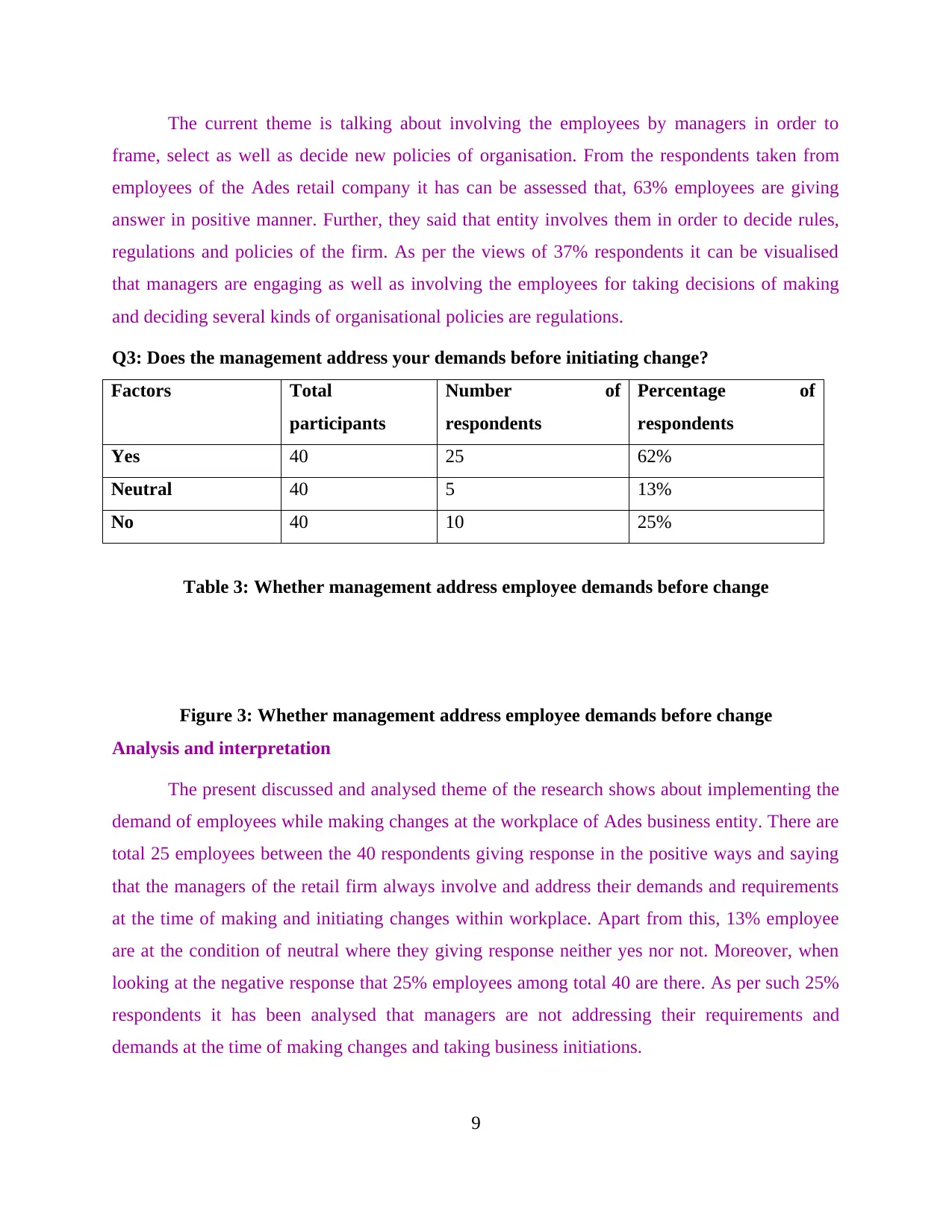
The current theme is talking about involving the employees by managers in order to
frame, select as well as decide new policies of organisation. From the respondents taken from
employees of the Ades retail company it has can be assessed that, 63% employees are giving
answer in positive manner. Further, they said that entity involves them in order to decide rules,
regulations and policies of the firm. As per the views of 37% respondents it can be visualised
that managers are engaging as well as involving the employees for taking decisions of making
and deciding several kinds of organisational policies are regulations.
Q3: Does the management address your demands before initiating change?
Factors Total
participants
Number of
respondents
Percentage of
respondents
Yes 40 25 62%
Neutral 40 5 13%
No 40 10 25%
Table 3: Whether management address employee demands before change
Figure 3: Whether management address employee demands before change
Analysis and interpretation
The present discussed and analysed theme of the research shows about implementing the
demand of employees while making changes at the workplace of Ades business entity. There are
total 25 employees between the 40 respondents giving response in the positive ways and saying
that the managers of the retail firm always involve and address their demands and requirements
at the time of making and initiating changes within workplace. Apart from this, 13% employee
are at the condition of neutral where they giving response neither yes nor not. Moreover, when
looking at the negative response that 25% employees among total 40 are there. As per such 25%
respondents it has been analysed that managers are not addressing their requirements and
demands at the time of making changes and taking business initiations.
9
frame, select as well as decide new policies of organisation. From the respondents taken from
employees of the Ades retail company it has can be assessed that, 63% employees are giving
answer in positive manner. Further, they said that entity involves them in order to decide rules,
regulations and policies of the firm. As per the views of 37% respondents it can be visualised
that managers are engaging as well as involving the employees for taking decisions of making
and deciding several kinds of organisational policies are regulations.
Q3: Does the management address your demands before initiating change?
Factors Total
participants
Number of
respondents
Percentage of
respondents
Yes 40 25 62%
Neutral 40 5 13%
No 40 10 25%
Table 3: Whether management address employee demands before change
Figure 3: Whether management address employee demands before change
Analysis and interpretation
The present discussed and analysed theme of the research shows about implementing the
demand of employees while making changes at the workplace of Ades business entity. There are
total 25 employees between the 40 respondents giving response in the positive ways and saying
that the managers of the retail firm always involve and address their demands and requirements
at the time of making and initiating changes within workplace. Apart from this, 13% employee
are at the condition of neutral where they giving response neither yes nor not. Moreover, when
looking at the negative response that 25% employees among total 40 are there. As per such 25%
respondents it has been analysed that managers are not addressing their requirements and
demands at the time of making changes and taking business initiations.
9
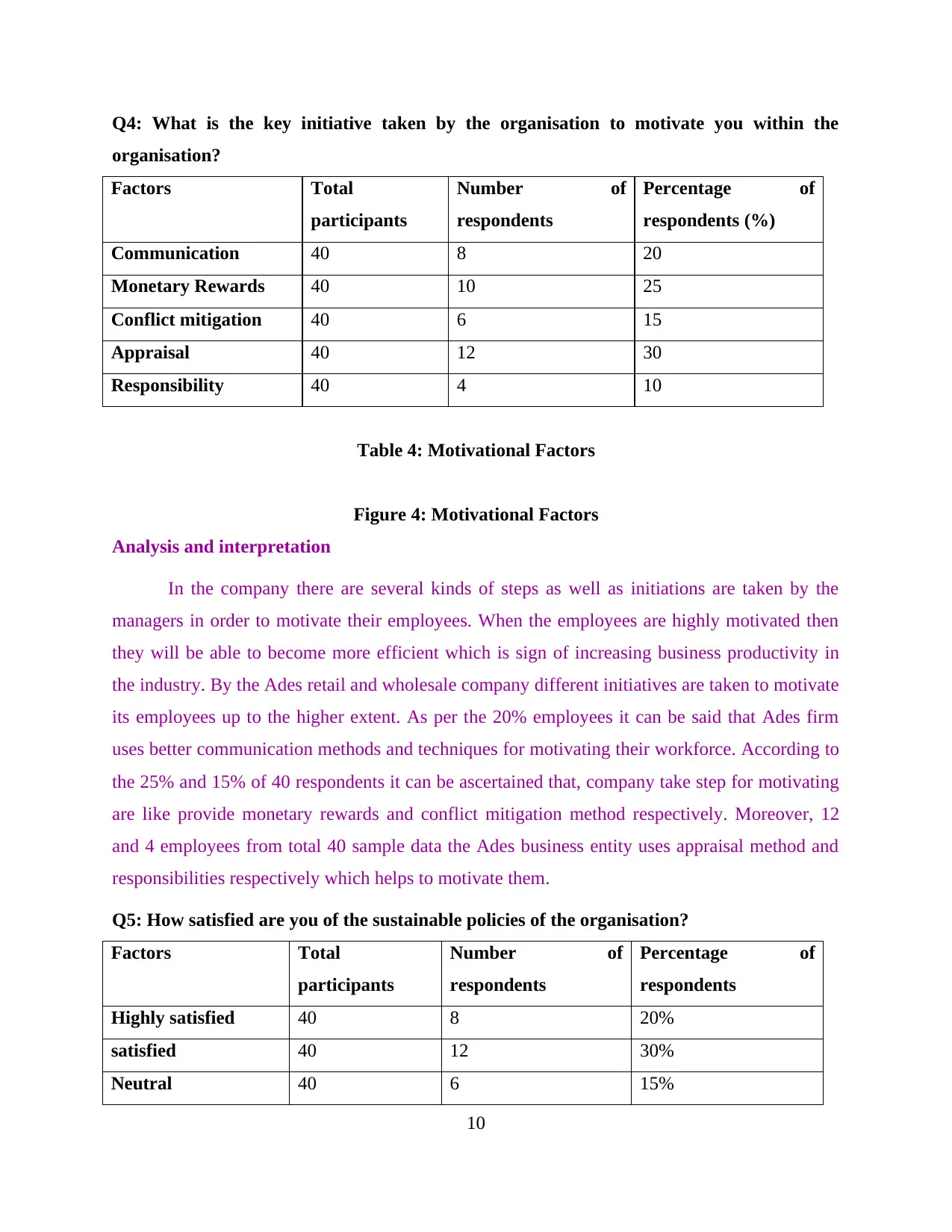
Q4: What is the key initiative taken by the organisation to motivate you within the
organisation?
Factors Total
participants
Number of
respondents
Percentage of
respondents (%)
Communication 40 8 20
Monetary Rewards 40 10 25
Conflict mitigation 40 6 15
Appraisal 40 12 30
Responsibility 40 4 10
Table 4: Motivational Factors
Figure 4: Motivational Factors
Analysis and interpretation
In the company there are several kinds of steps as well as initiations are taken by the
managers in order to motivate their employees. When the employees are highly motivated then
they will be able to become more efficient which is sign of increasing business productivity in
the industry. By the Ades retail and wholesale company different initiatives are taken to motivate
its employees up to the higher extent. As per the 20% employees it can be said that Ades firm
uses better communication methods and techniques for motivating their workforce. According to
the 25% and 15% of 40 respondents it can be ascertained that, company take step for motivating
are like provide monetary rewards and conflict mitigation method respectively. Moreover, 12
and 4 employees from total 40 sample data the Ades business entity uses appraisal method and
responsibilities respectively which helps to motivate them.
Q5: How satisfied are you of the sustainable policies of the organisation?
Factors Total
participants
Number of
respondents
Percentage of
respondents
Highly satisfied 40 8 20%
satisfied 40 12 30%
Neutral 40 6 15%
10
organisation?
Factors Total
participants
Number of
respondents
Percentage of
respondents (%)
Communication 40 8 20
Monetary Rewards 40 10 25
Conflict mitigation 40 6 15
Appraisal 40 12 30
Responsibility 40 4 10
Table 4: Motivational Factors
Figure 4: Motivational Factors
Analysis and interpretation
In the company there are several kinds of steps as well as initiations are taken by the
managers in order to motivate their employees. When the employees are highly motivated then
they will be able to become more efficient which is sign of increasing business productivity in
the industry. By the Ades retail and wholesale company different initiatives are taken to motivate
its employees up to the higher extent. As per the 20% employees it can be said that Ades firm
uses better communication methods and techniques for motivating their workforce. According to
the 25% and 15% of 40 respondents it can be ascertained that, company take step for motivating
are like provide monetary rewards and conflict mitigation method respectively. Moreover, 12
and 4 employees from total 40 sample data the Ades business entity uses appraisal method and
responsibilities respectively which helps to motivate them.
Q5: How satisfied are you of the sustainable policies of the organisation?
Factors Total
participants
Number of
respondents
Percentage of
respondents
Highly satisfied 40 8 20%
satisfied 40 12 30%
Neutral 40 6 15%
10
⊘ This is a preview!⊘
Do you want full access?
Subscribe today to unlock all pages.

Trusted by 1+ million students worldwide
1 out of 22
Related Documents
Your All-in-One AI-Powered Toolkit for Academic Success.
+13062052269
info@desklib.com
Available 24*7 on WhatsApp / Email
![[object Object]](/_next/static/media/star-bottom.7253800d.svg)
Unlock your academic potential
Copyright © 2020–2025 A2Z Services. All Rights Reserved. Developed and managed by ZUCOL.





